Saturday, August 4. 2012
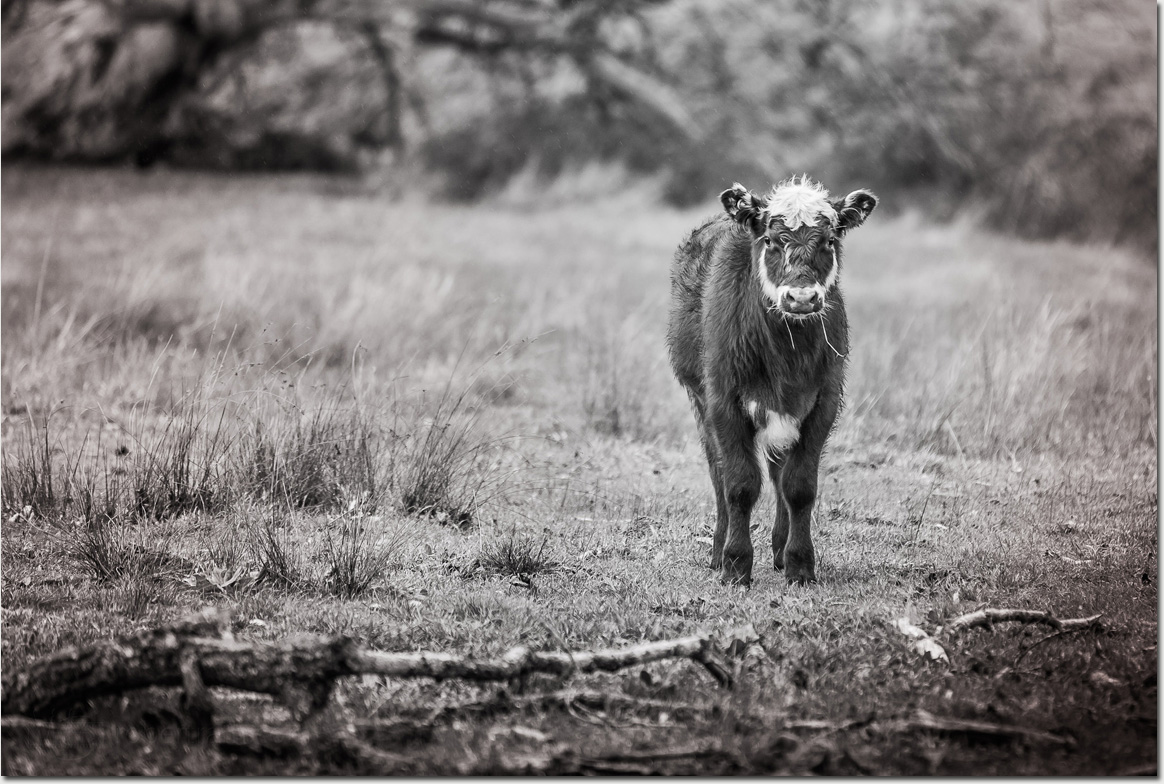
I love taking detours home!
The drive to visit my home town of Tanunda in the Barossa Valley has become more convenient than ever due to the new expressway built in the last couple of years. With this convenience there comes a price. I no longer get to meander through country towns, rolling vineyards or out of the way country roads.
Every now and then I decide to take the long way home through the Barossa Ranges and the Adelaide Hills. It might take twice as long but there is so much to see and it's a lovely break from bitumen, power-lines, street lamps and traffic.
This winter calf was in a paddock on the Trial Hill road and ran along side us as we were passing. I quickly pulled over, camera at hand and he bounded right up to the fence. His bravado instantly evaporated as I got out of the car and he headed back into the paddock out of harms way. I had hoped to get closer shot but a combination of rain, fresh cow patts and an intimidating bull eying me off from a distance kept me on my side of the fence.
Photo: Robert Rath, '366 Days of 2012, Day 217 - Winter Calf'. 1/400 sec f/2.8 ISO-320 200mm
Friday, August 3. 2012
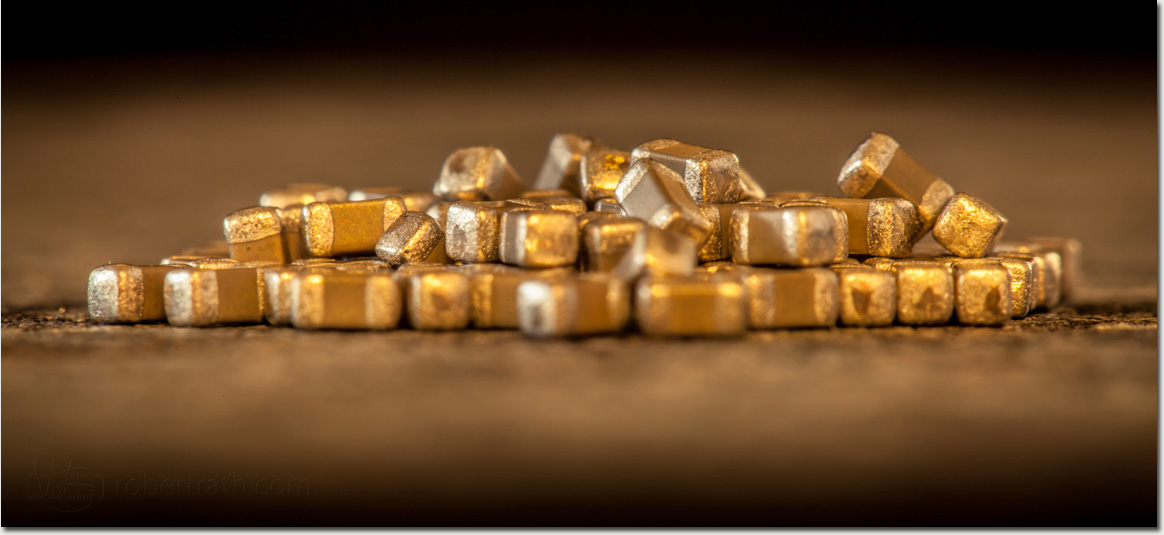
This kind of gold has nothing to do with Olympic medals!
This entire little pile of 100 gold blocks would fit on the nail of my little finger and modern electronics is full of them. When I first started my career the equivalent parts would have been the size a 20cent piece for each one.
Their technical name is called a 'ceramic multilayer capacitor' and their job in modern electronics, like mobile phones and televisions, is to store electric charge. Think of them as tiny little batteries that you can charge and discharge.
Actually these parts are now quite large compared to version half or even a third their size.
Miniaturising electronic components is not only good for making more compact products. Smaller parts means less material means cheaper manufacturing using less raw materials and hence less impact on our environment. They are as good as gold!
To create this image I used a 200mm (100mm + 2x converter) macro setup with a very small aperture for a large depth of field (not that is seems like it), a low ISO setting and a long 20 second exposure. During the exposure I applied some strobe lighting from the left to create additional highlights and contrast.
Photo: Robert Rath, '366 Days of 2012, Day 216 - Good as Gold'. 20 sec f/32 ISO-200 macro + off camera fill strobe
Thursday, August 2. 2012
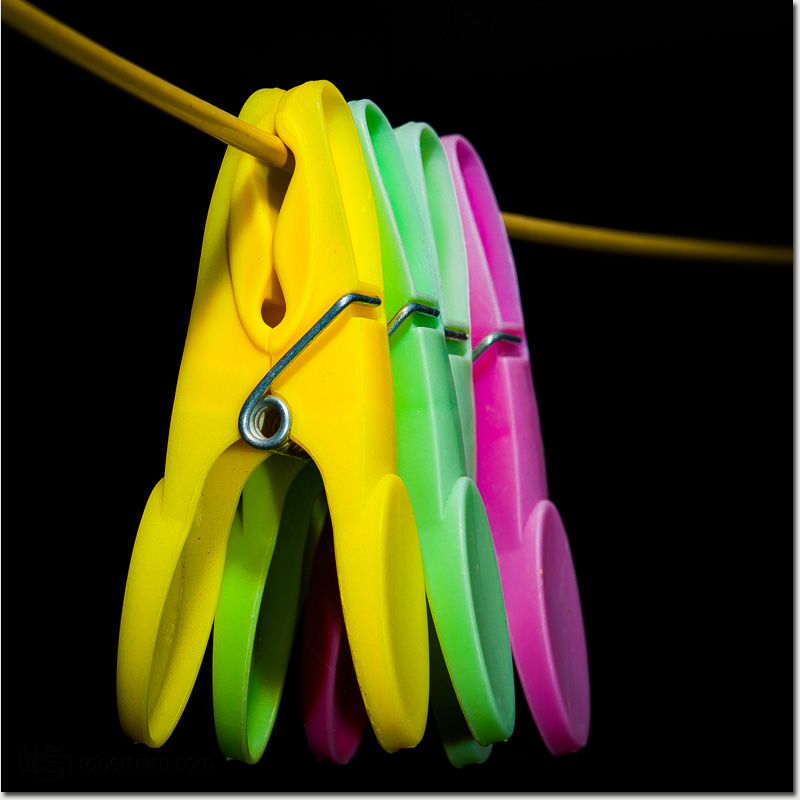
The most ordinary of things take on a new perspective in a different light!
Two different lights in this case! One way to really make an ordinary object stand out is to completely isolate it from its normal environment. There are many ways to place objects in all kinds of negative space, tight depth of field being one of the most popular. For this image I have use powerful strobe lighting.
In a studio setting it is possible to do all kings of wonderful things with lighting but not so easy for a stroll around the garden hand holding everything. Because I wanted a wide depth of field I really needed two strobes to give this image any sense of depth. With only two hands my setup was pretty basic with camera equipped with hot-shoe flash in one hand and a slave strobe in the other.
For this image I placed the slave strobe above and to the right while the hot-shoe flash provided gentle front lighting. I reckon I pegged this one!
Photo: Robert Rath, '366 Days of 2012, Day 215 - Pegged'. 1/100 sec f/25 ISO-100 100mm + off camera strobe
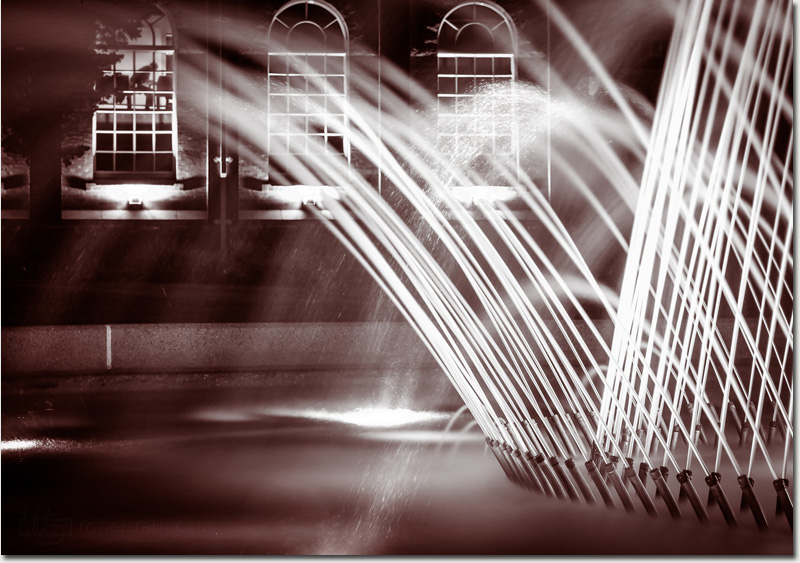
Beautifully lit fountains at night are pretty and make for great photographs.
But after you have seen about 500 different version of pretty fountains the images start to grow tiring. My daughter requested that I photograph this fountain that she found because 'it's pretty!' After a bunch of typically cliched 'pretty' fountain shots (this one even cycled through the colours of the rainbow) I could not stand it any longer and started experimenting with the fountain in its environment.
Off in the background there was an interesting building with arched windows that made and interesting contrast and then I saw him; the man in the window at what appears to be a piano.
I watched him for a while and it looked like he was moving back and forth between a desk and the piano. Perhaps he was composing, perhaps he was arranging, perhaps he was doing something else altogether different. What ever he was doing it made a wonderful point of interest in yet another pretty fountain image!
Photo: Robert Rath, '366 Days of 2012, Day 214 - Piano Man'. 30 sec f/22 ISO-50 105mm
Tuesday, July 31. 2012
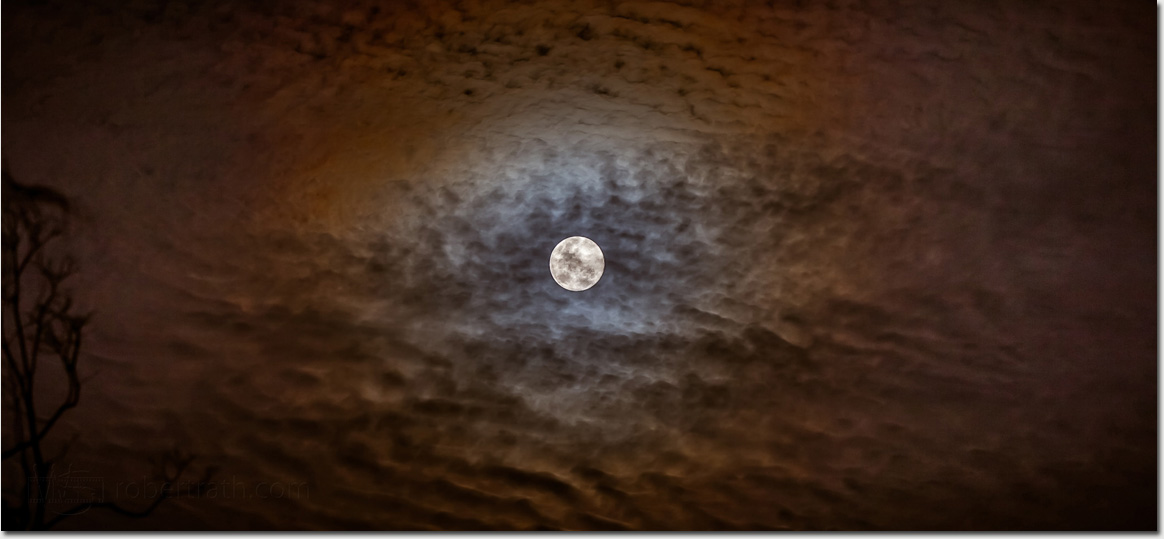
The combination of cloud and moon can be quite amazing!
I loved the old SpiderMan cartoons and I especially loved the dark and moody night time skies as SpiderMan would traverse the city skyline to arrive always just in time at the scene of the crime!
For those who can remember those old SpiderMan cartoons I'm sure you will be singing the theme song in your heads for the rest of the day!
There was not much cloud in the sky tonight but just as the moon rose and the last vestiges of amber twilight hung in the sky, the clouds that framed the rising moon reminded me of those old SpiderMan cartoons.
Photo: Robert Rath, '366 Days of 2012, Day 213 - SpiderMan Moon'. 1/8 sec f/4.0 ISO-320 123mm
Monday, July 30. 2012
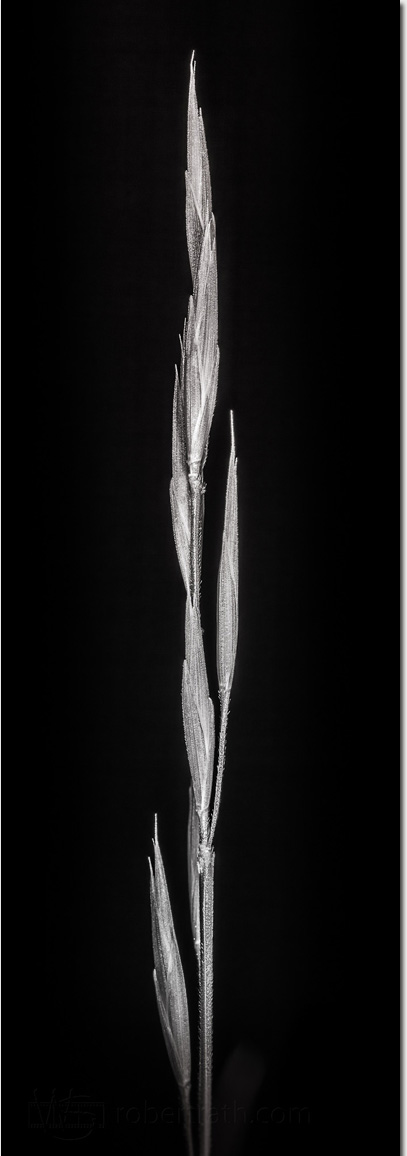
While playing with strobes and dark backgrounds I decided to go for a walk around the garden.
I found some interesting things but this stalk of grass seed caught my attention. It was so straight and true with not a hint of a lilt.
I knelt down and began capturing a few images. Before long our dog Tin Tin wandered over for a bit of a look, decided the grass looked good enough to eat and there was then end of my subject and my photo-shoot for the day!
Photo: Robert Rath, '366 Days of 2012, Day 212 - Tall and True'. 1/100 secs f/25 ISO-160 100mm + 2 x Strobes
Sunday, July 29. 2012
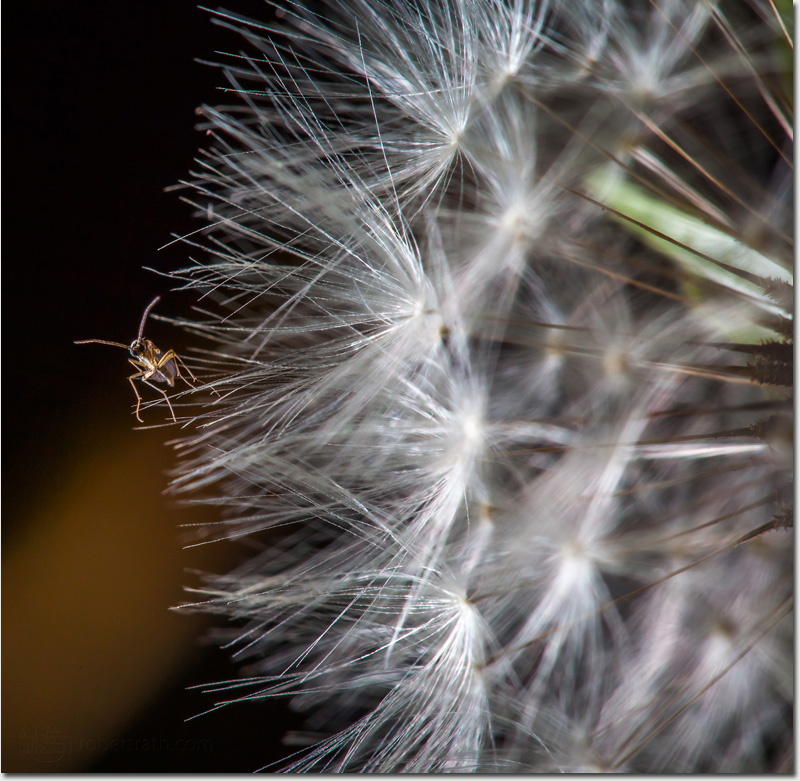
I'm not a big fan of photographing bugs!
Actually I enjoy the challenge of macro-photography but when it comes time to write about what I've captured I am faced with the dilemma of identifying the actual critter under the microscope.
For most of my images involving critters I have been successful but tonight I am just going to throw my hands up and call this one Artisticus participanis.
Photo: Robert Rath, '366 Days of 2012, Day 211 - Dandelion Walker'. 1/200 secs f/32 ISO-160 100mm + 2 x Strobes (off camera)
Saturday, July 28. 2012
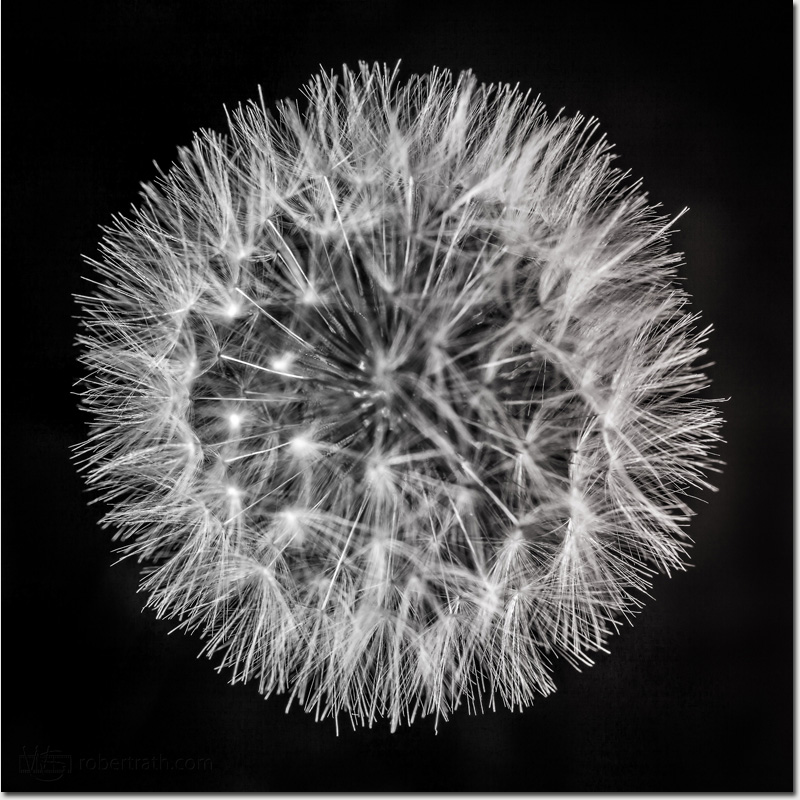
There's a super nova in our garden. A little biological super nova.
Just as a super nova spreads its seeds of matter through the cosmos, so does the dandelion flower.
As kids we loved picking them and just like blowing out the candles of a birthday cake we used to try and blow off every seed with a single breath.
Initially I tried to use a tripod but found it was simply easier to pre-focus the lens and slowly move the camera in and out of focus by hand, firing the shutter and strobes just as I moved through the focal plane. This allowed me to take the image from directly above obscuring the stem.
For lighting I used two strobes, one placed on the ground to the right and facing back up at the dandelion, the other directly to the left. The objective of the lighting was to create a sense of depth through the space of the dandelion.
Photo: Robert Rath, '366 Days of 2012, Day 210 - Supernova'. 1/200 secs f/32 ISO-160 100mm + 2 x Strobes (off camera)
Friday, July 27. 2012

I never get tired of the beach.
Having our beach in a metropolitan setting creates opportunities to mix both natural and man-made structures. Our jetties are favorites and yes jetties have been done to death but I intend flogging this one a little longer.
Tonight I came down with just the 15mm FE prime which made me look for perspectives suited to this lens. Here is my jetty perspective.
Photo: Robert Rath, '366 Days of 2012, Day 209 - Jetty Perspective'. 1/500 secs f/13 ISO-640 15mm FE
Thursday, July 26. 2012
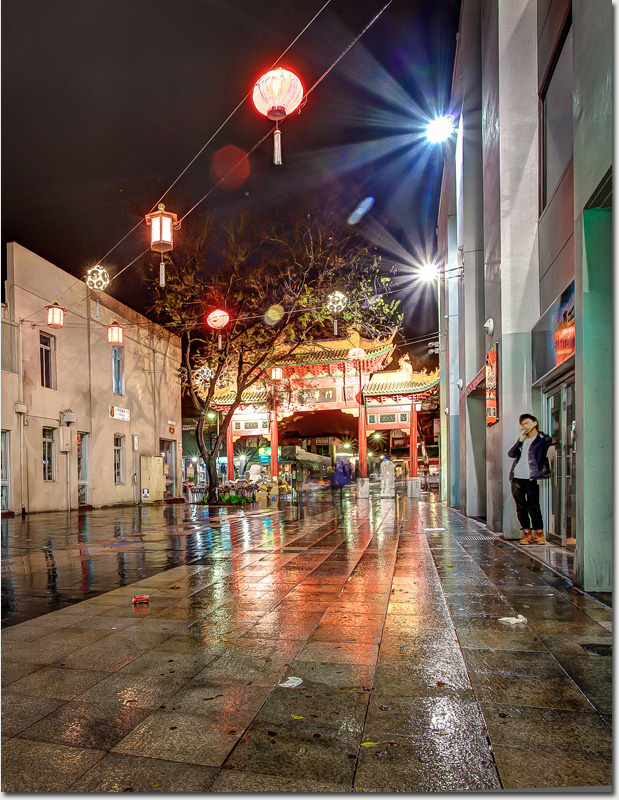
Chinatown off Gouger Street in the city should be all hustle and bustle.
Instead everyone is sheltered in warm and cosy places.
One dude takes an idle moment for a smoke. His vice more compelling that the warm inviting comfort of a nearby restaurant.
Photo: Robert Rath, '366 Days of 2012, Day 208 - An Idle Moment in Chinatown'. 0.2/0.8/3.2/13 secs f/11 ISO-640 17mm hdr
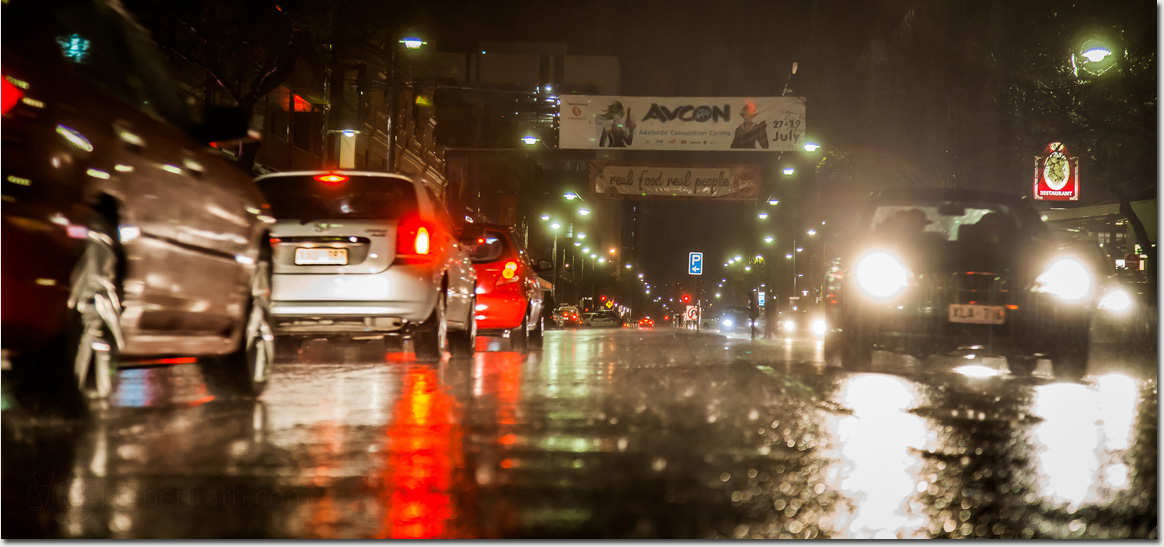
Standing in the rain. Caught on an island between the traffic.
For the first 30 minutes of taking photos in the rain I hate it! After that I get over it and have a great time.
Photo: Robert Rath, '366 Days of 2012, Day 207 - Caught In The Middle'. 1/20 secs f/4.0 ISO-1600 80mm
Tuesday, July 24. 2012
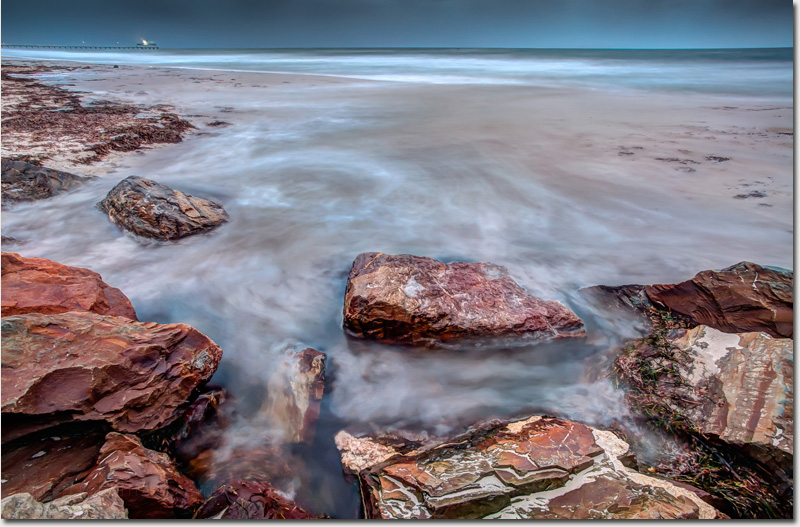
I looked up at the clock and it was just 14 minutes until sunset.
I had not captured any images yet so I grabbed my camera and headed down the to the beach to see how the last rays of light for the day would fall. As I approached I saw the last vestige of sun descend behind and be obscured by cloud. There would be no sunset images made here tonight!
Although I found myself on a cold, windy and drizzly beach, the light was soft and almost warm albeit rapidly fading. I made quite a few images in the receding light and this one was my favorite.
For this image I liked the composition of rock, jetty, seaweed sand, sea and sky but it needed something extra. A little patience paid off as a series of large waves came through right up the beach to where I was positioned and this is the result.
Photo: Robert Rath, '366 Days of 2012, Day 206 - Henley Beach Twilight'. 4/13/30 secs f/16 ISO-320 19mm hdr
Monday, July 23. 2012

Trying to photograph an object by laser lighting is strange beyond expectations!
You might think that the coherent and precise nature of a laser source might yield better image resolution than natural light sources. Actually red laser light completely destroys it through interference rendering a perceived image acuity more reminiscent of a 640x480 VGA video camera.
It gets even stranger when you try to process the image in Adobe Lightroom. The sharpness and noise reduction sliders have almost no affect on the image at all! Somehow the captured patterns of interference seem to counteract the maths in the image processing.
Anyway, regardless of the curiosity of it all I am a little disappointed that the results were not as dramatic as I had hoped. Here is my image for the day, a single red laser beam incident on a prism in a smokey room.
Photo: Robert Rath, '366 Days of 2012, Day 205 - Laser Light'. 30 secs f/16 ISO-100 100mm macro
Sunday, July 22. 2012

Tonight while driving along the coast I was struck by how luminous the seascape was.
The sunset had been well hidden by cloud but the contrasts in the sky were amazing. Everything around seemed to the bathed in a soft gentle glow.
The reflected light from a calmed sea created a lovely ambiance juxtaposed to a dramatic sky.
I would have liked to have found a better place to make this image but perhaps the orange glow on the sand from the esplanade streetlights gives a little warmth to an otherwise cold scene.
Photo: Robert Rath, '366 Days of 2012, Day 204 - After Dark'. 20 secs f/13 ISO-1600 24mm
Saturday, July 21. 2012
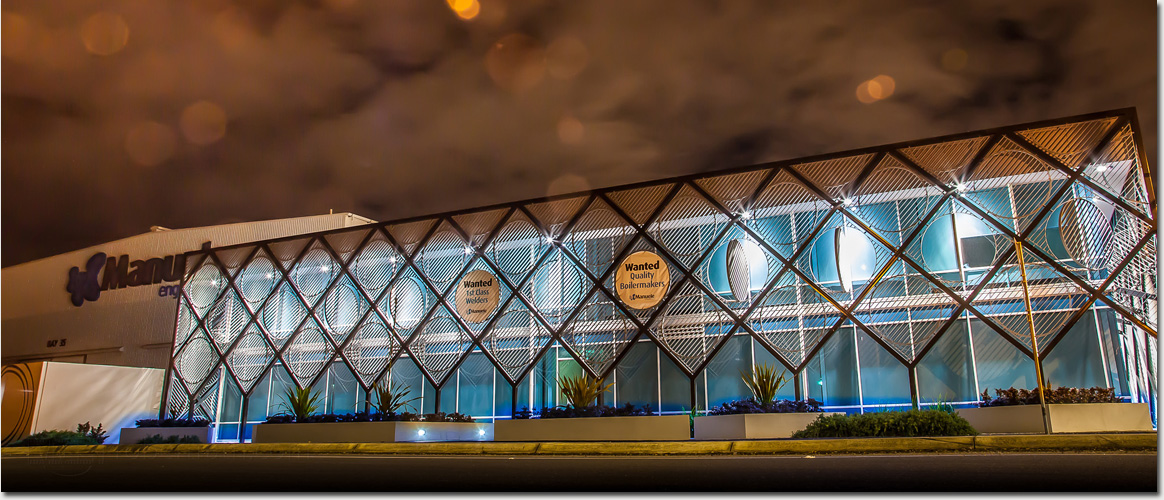
As an engineer with a career in manufacturing I'm not ashamed to admit, I love factories.
Some time back we watched the beginning of new creation at the end of Morphett Road near the back of the Adelaide airport. Over several months we observed a building landscape transform into a state of the art industrial premises.
For some months more we guessed what this new facility would be used for. It was clearly a manufacturing premises but while the internal fit-out progressed we just had to guess.
Finally when the signage was put in place we learned that this new building is the new home of Manuele Engineers, a South Australian family business.
The facility is dedicated to complex and high precision steel engineering and fabrication work of which takes up four bays of the facility with one additional bay dedicated to industrial coatings.
I was hoping for this high tech looking building to be some high tech electronics or aerospace type manufacturing facility. Alas its just a paint-shop. A state of the art, high tech paint-shop! Regardless, it is great to see confidence in the future of South Australian manufacturing!
Photo: Robert Rath, '366 Days of 2012, Day 203 - Factory TruCoat'. 8 secs f/14 ISO-1600 24mm

As an engineer with a career in manufacturing I'm not ashamed to admit, I love factories.
Some time back we watched the beginning of new creation at the end of Morphett Road near the back of the Adelaide airport. Over several months we observed a building landscape transform into a state of the art industrial premises.
For some months more we guessed what this new facility would be used for. It was clearly a manufacturing premises but while the internal fit-out progressed we just had to guess.
Finally when the signage was put in place we learned that this new building is the new home of Manuele Engineers, a South Australian family business.
The facility is dedicated to complex and high precision steel engineering and fabrication work of which takes up four bays of the facility with one additional bay dedicated to industrial coatings.
I was hoping for this high tech looking building to be some high tech electronics or aerospace type manufacturing facility. Alas its just a paint-shop. A state of the art, high tech paint-shop! Regardless, it is great to see confidence in the future of South Australian manufacturing!
Photo: Robert Rath, '366 Days of 2012, Day 203 - Factory Manuele Engineers'. 8 secs f/14 ISO-1600 24mm
Friday, July 20. 2012
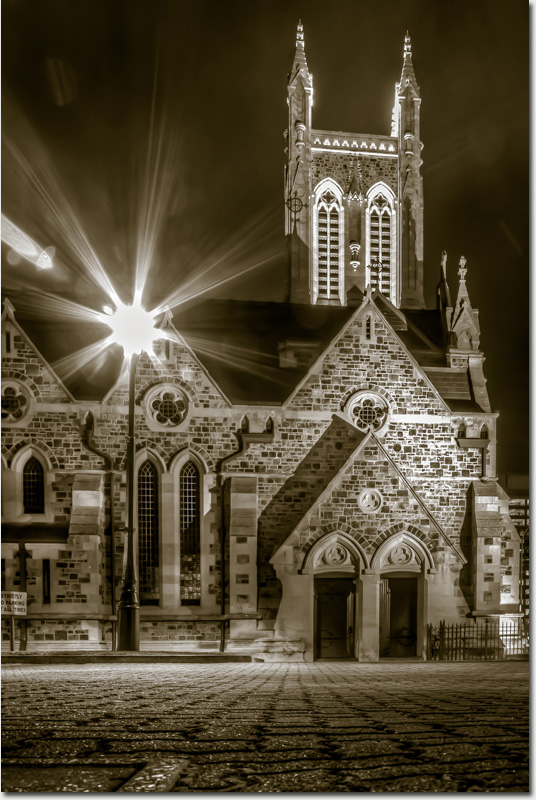
I don't know much about this church. Other than that I pass by it every week.
The problem with many of the interesting photographic subjects in the city is parking close by in order to capture an image. This time I was lucky enough to find a park within a quick walk.
The church had some really difficult lighting on it. Heavily lit from the right with the bright lamp shining directly back into the car park and me. I figured if I was going to get an image I liked it would have to be a hdr composite.
I tried a few positions to take the image from but in the end I liked from ground level.
Photo: Robert Rath, '366 Days of 2012, Day 202 - St Francis Xavier's Cathedral'. 0.5/2.5/10 sec f/16 ISO-640 32mm hdr
Thursday, July 19. 2012
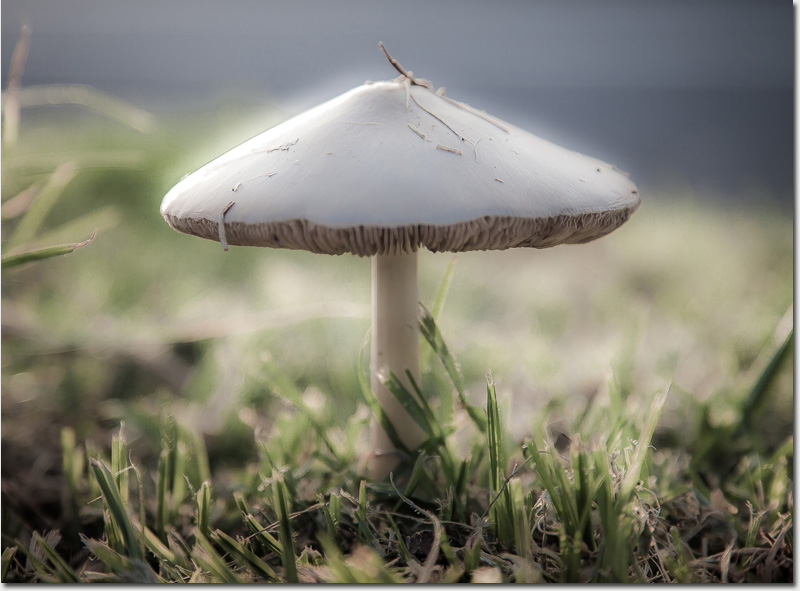
There's magic a growing in my roadside garden.
This morning I spotted a mushroom growing in the grass verge but the light was all wrong. Passing the same place in the late afternoon I wondered if it would still be there.
Would it have been idly kicked by a passing school child, or perhaps wee'd on by an itinerant dog or maybe even driven over by a badly parked car? Well as they say, 'good fortune follows the ...' (hmm, what is it that they say?). Anyway there it was and the late afternoon light was perfect.
So with image now captured I'll leave it where it is. Perhaps for some culinary thrill seeker to meet an untimely demise...
Photo: Robert Rath, '366 Days of 2012, Day 201 - It's Magic'. 1/125 sec f/4.0 ISO-100 100mm
Wednesday, July 18. 2012
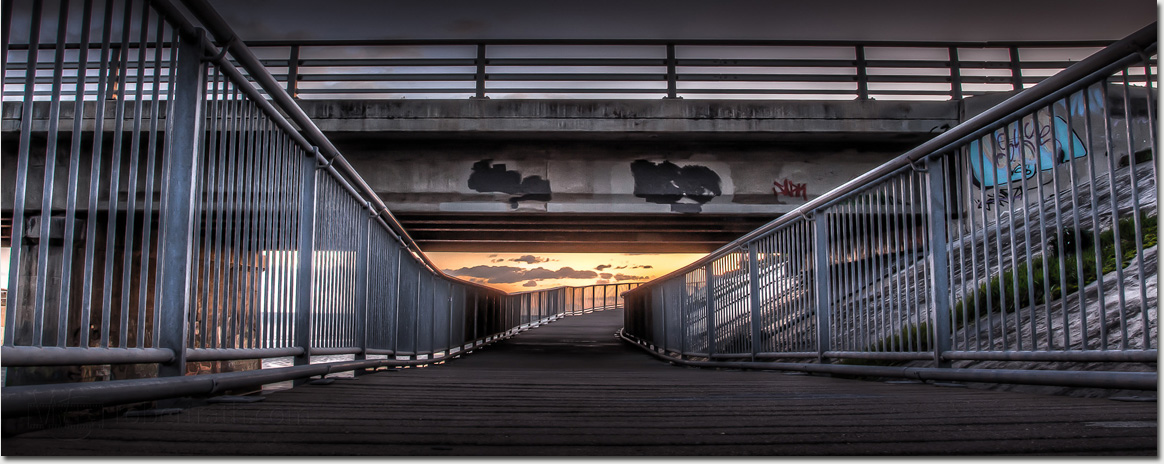
I'm experimenting with new ways to show the cliched-to-death sunset!
In this image I have again used 3 images of different exposure to bring the the highlights of the sunset and the shadows tones of the bridge and pathway into visual harmony.
Photo: Robert Rath, '366 Days of 2012, Day 200 - Beyond Concrete and Steel'. 0.5/2/8 secs f/16 ISO-640 24mm

This is a real out of the camera image!
It might be hard to imagine that this is not some Photoshop creation but here it is. In fact here's how I made it just in case you are curious.
I placed a clear marble (with imperfections in roundness and clarity) on a small pillar of magnetic balls. I then draped my camera in Christmas tree lights, the old fashion kind with lots of different colours. I strategically positioned a small mirror behind the subject to create some additional internal colours and finally I made the shot wide open at f/2.8 to get that glorious bokeh in the now reflected background.
So when it comes to getting creative it is amazing what a little experimentation will provide.
Photo: Robert Rath, '366 Days of 2012, Day 199 - Bokeh Ball'. 1/2s f/2.8 ISO-640 100mm macro
Tuesday, July 17. 2012
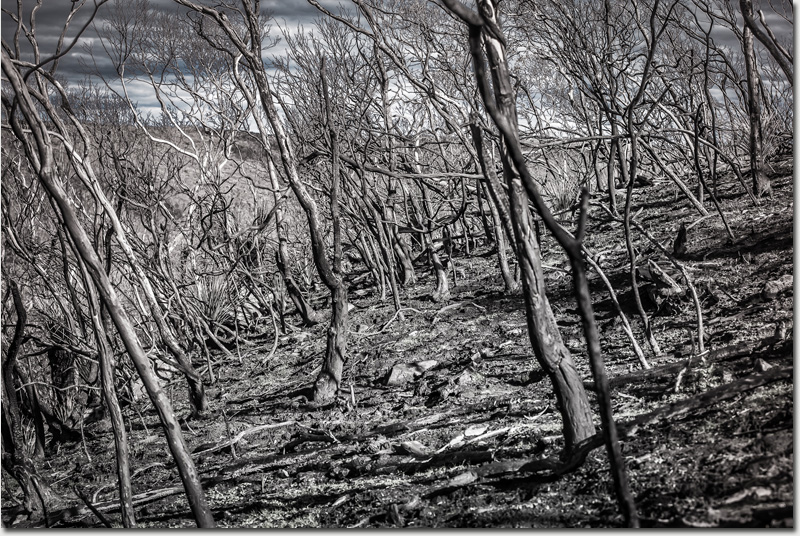
A black and charred landscape made all the more bleak through a black and white perspective.
The fire which closed some of the Deep Creek conservation park back in April is actually good for many plant species which depend on fire for both germination and clearing of ground litter for access to sunlight during early development.
Photo: Robert Rath, '366 Days of 2012, Day 198 - After the Fire'. 1/800s f/5.6 ISO-640 70mm
Sunday, July 15. 2012
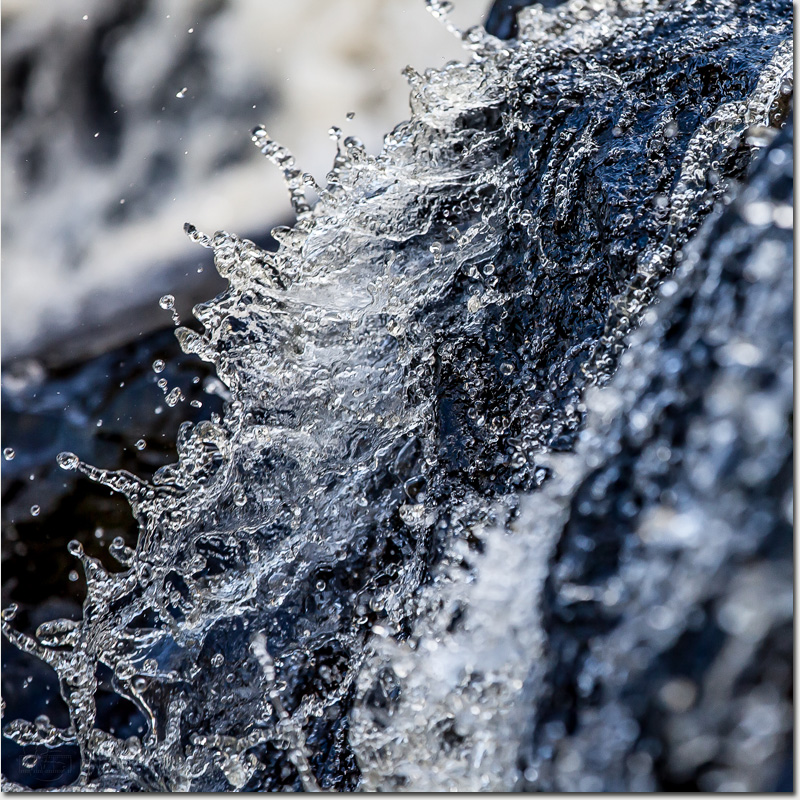
We see moving water every single day but how often do we think about its form?
Photographers regularly take advantage of extremes of the form of water to create striking interpretations. Two of the most common examples around at present would have to be long exposure sea-scapes and super-fast frozen water splash effects. These images fascinate us becuase they show water in a form we can not ordinarily perceive with our own eyes.
Both types of images have their challenges. Long exposures must be made with the camera well protected from and movement for the entire exposure period which could be many minutes and require very heavy light filtering (like welder's goggles) to prevent over exposure. High speed event images which freeze droplets of water in space are so random an unpredictable that many images may need to be taken to get something well composed and visually pleasing.
While photographing this small waterfall I originally wanted to try the long exposure effect but it was too small and I could not create a pleasing composition. So with that I cranked up the ISO and the shutter speed and got this frozen effect instead.
Photo: Robert Rath, '366 Days of 2012, Day 197 - Frozen Water'. 1/2000s f/4 ISO-1600 200mm
Saturday, July 14. 2012
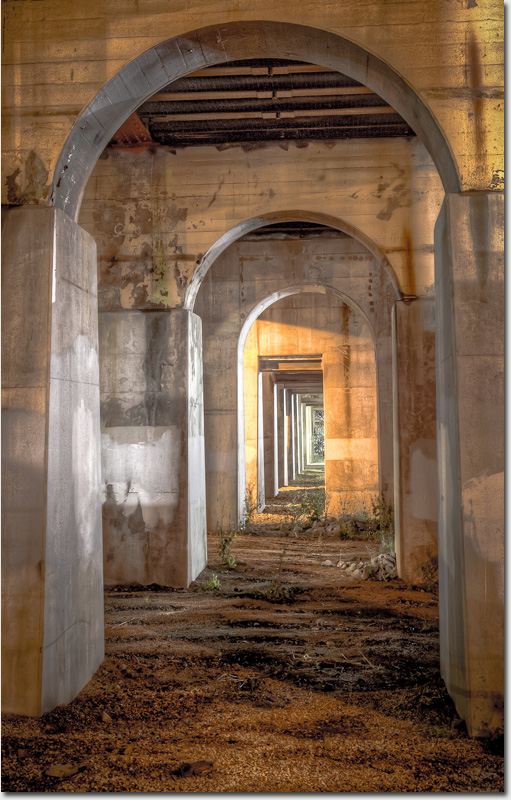
The original 'Port Adelaide - Commercial Road' train station was built in 1916.
Though reduced in scale and scope it is still in active use today after a long and dynamic history.
Last night I headed out to Port Adelaide for a night-time photowalk, anticipating images of water, vessels, the docks and the surrounding historic town. However I never quite made it there. As I was heading into Port Adelaide on Commercial Road I noticed the old railway station and decided I'd pull over for a quick look. I have passed under the viaduct of this station hundreds of times in my life and often thought how interesting the construction appeared. The verdict, a wonderful photographic site!
I stayed for quite some time taking images and looking around and before long I had become chilled to my core due to the cold. With that I decided to call it an evening and head home. The docks can wait for another time.
Photo: Robert Rath, '366 Days of 2012, Day 196 - Port Adelaide Railway Station'. 1/(2+8+30)sec f/8 ISO-1600 35mm hdr
Friday, July 13. 2012
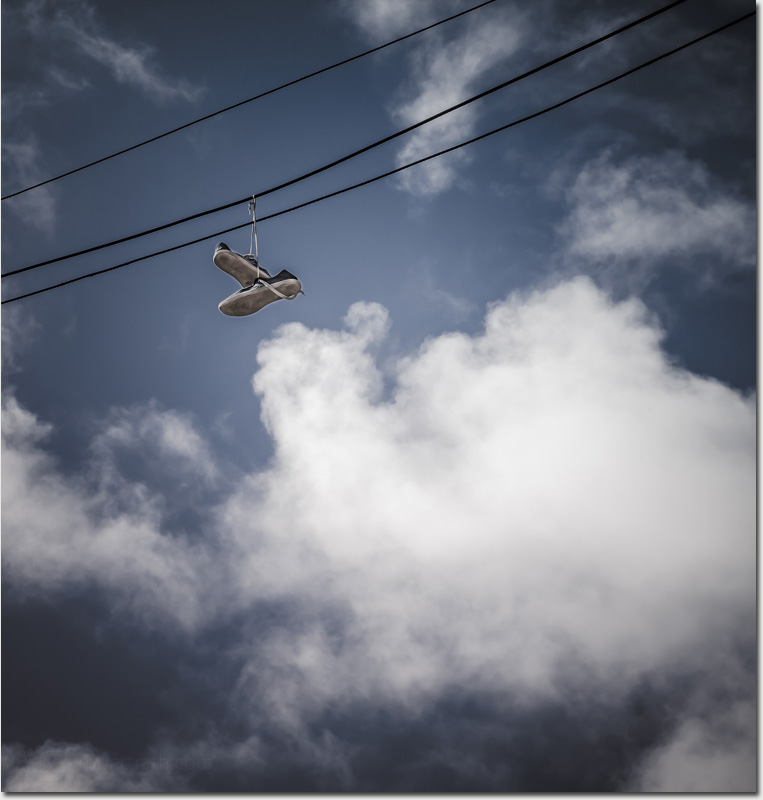
I am amazed how often I see shoes, either a pair or one on its own, in the most odd places.
Immediately I wonder, what is the story here? With shoes on power-lines I imagine a kid's prank or maybe a school boy bully. A single stiletto in a gutter conjures more grievous thoughts. A pair of flip-flops by a creek might mean someone walking down a shallow stream and forgetting where they started. To me abandoned shoes alway come with a story and more often than not, a story of my own imagining.
To capture this image I used a small aperture as I wanted the gorgeous details in the clouds to be a dramatic backdrop and found a piece of open sky as the negative space in which to place the shoes.
Photo: Robert Rath, '366 Days of 2012, Day 195 - Walked Home Barefoot'. 1/320sec f/16 ISO-640 70mm
Thursday, July 12. 2012
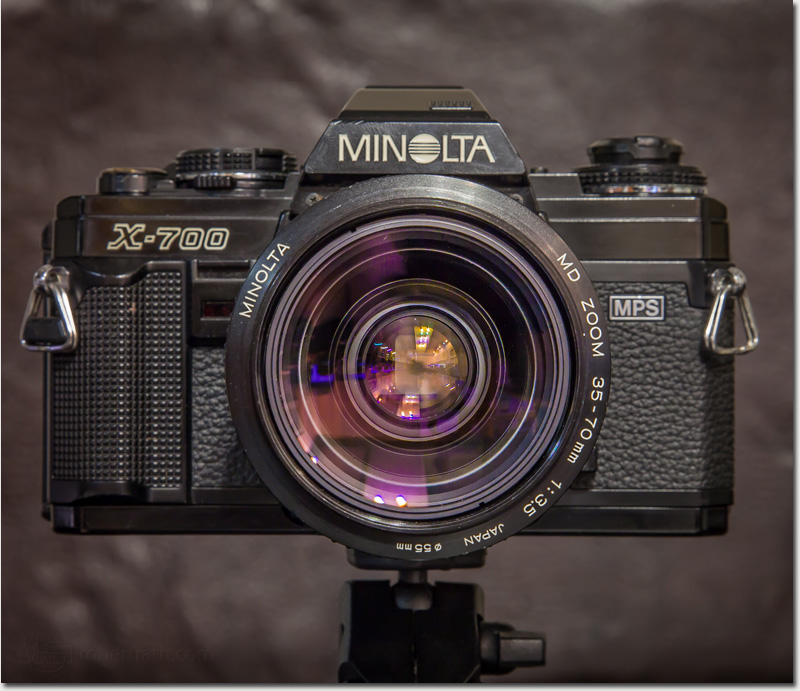
Today I struggled for inspiration for something new. In-fact I almost dreaded running out of day without something I could publish in keeping with my expectations of one decent image every day!
Finally I found inspiration. While reading a G+ post from another photographer and how they made a switch from Minolta to Nikon in the early digital days. The post brought back memories for me of the Minolta X-700 which came out around 1983 and would be the SLR camera I used for the best part of 20 years before Canon wooed me away in 2003 with their EOS Rebel.
I pulled the X-700 out of the cupboard, dusted off the cobwebs and gave it the once over. Film! It was loaded! Next I turned it on. It came to life! I pressed the shutter and I took a photograph!
This all felt so strange, so nostalgic and almost surreal. I nearly forgot I needed to wind on the film when I could not work out would it why it would not take a second photo!
So here is my image today of the Minolta X-700 which served me well for 20 years of photography. So what photo did I take with the re-discovered X-700? The Canon of course!  Photo: Robert Rath, '366 Days of 2012, Day 194 - Reminiscing'. 6sec f/16 ISO-200 105mm
Photo: Robert Rath, '366 Days of 2012, Day 194 - Reminiscing'. 6sec f/16 ISO-200 105mm
Wednesday, July 11. 2012
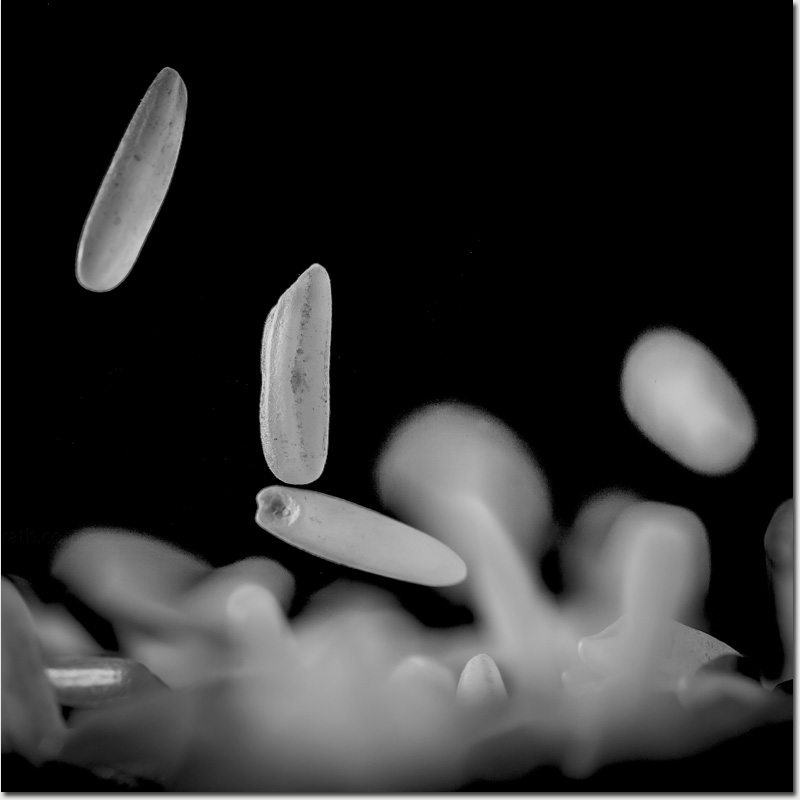
'We're Free' started as an experiment to see what happens when you place small similar object onto a loudspeaker cone, in the case rice.
I first tried simply playing random music but the inconsistency of cone movement meant that nothing would happen until quite loud levels and then one decent hit of bass would send rice flying onto the table and the floor.
Next I used a synthesizer to generate controlled low frequency sine waves and this is where the fun really began. I could create all kings of crazy effects with different frequencies and levels but nothing I could easily photograph.
In the end I simply cranked up the level until rice flew everywhere taking this image! I'll clean up the mess in the morning!
Photo: Robert Rath, '366 Days of 2012, Day 193 - We're Free'. 1/200s f/11 ISO-200 100mm macro + strobe x 2
Tuesday, July 10. 2012
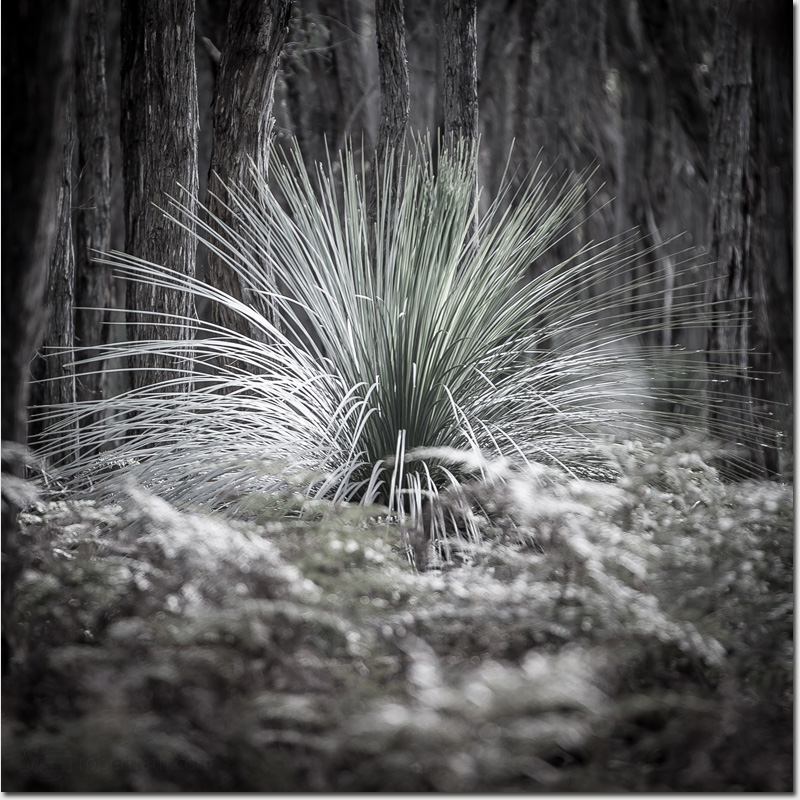
As I looked into the bush, there in the distance under a shining beam of sunlight shone a perfect yacca!
Photo: Robert Rath, '366 Days of 2012, Day 192 - Yacca'. 1/200s f/2.8 ISO-160 200mm
Monday, July 9. 2012
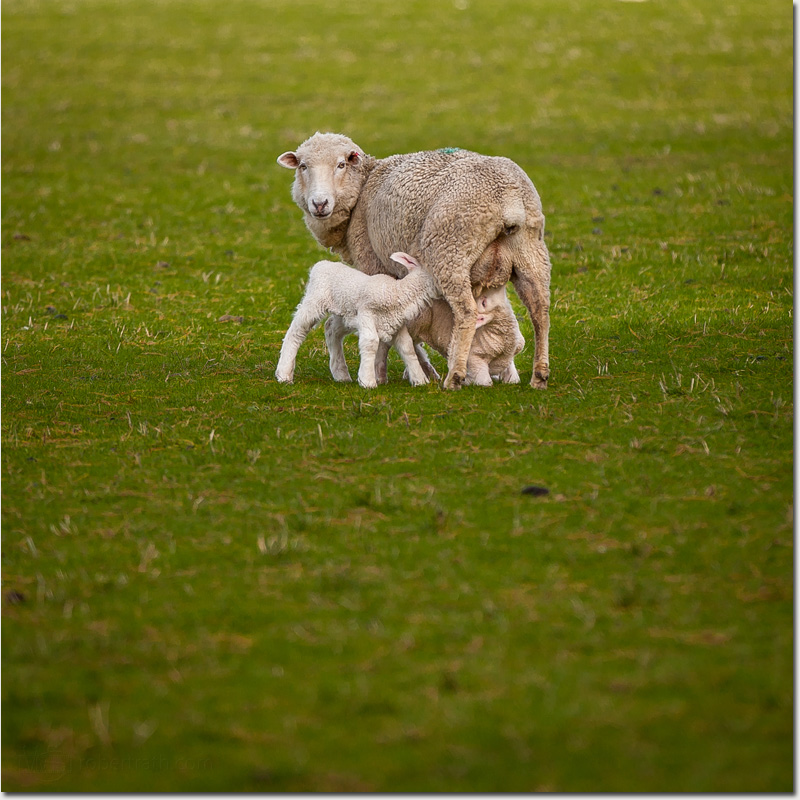
Winter time is lambing season here down on the Fleurieu Peninsula.
Odd really that an animal would choose to bear young in our coldest time and wettest time. Unless of course you are aware that these new newborns would not survive our 40deg summers!
These two little lambs are oblivious to my approach but mum is not as she gives me a wary eye. 5 seconds later mum is off in the opposite direction with confused lambs in hot pursuit. Lunch will have to wait.
Photo: Robert Rath, '366 Days of 2012, Day 191 - Lunchtime'. 1/1250s f/2.8 ISO-160 200mm
Saturday, July 7. 2012

Waiting for the moon to rise above the treeline I could not help be captivated by how the leaves were backlit by the clouds filled with moonlight.
The actual moon itself turned out to be a bit disappointing due to the cloud cover but I am happy with the silhouette.
Photo: Robert Rath, '366 Days of 2012, Day 190 - Moonrise'. 4s f/5.0 ISO-1600 200mm

Visual recursion is something some of us have experienced by pointing a video camera at its own monitor. That seemingly infinite diminishing set of images within images.
I never expected the same thing when I set about to photograph the aperture of my lens using the lens itself. I initially set up with the lens focused on its own nodal point, the aperture blades. It was a compromise between depth of field and a pleasing visual position for the blades to be in. (I have never heard of anyone ever setting the aperture for this reason!). On taking a few test images I noticed the reflection of the camera body off the camera's reflective CMOS sensor. I thought COOL!
Getting the camera body, as reflected off the CMOS sensor, in focus simply came down to trial and error as I simply could not get enough light to preview manual focus.
Here's the end result, 'Recursion', I hope you like it.
Photo: Robert Rath, '366 Days of 2012, Day 189 - Recursion'. 20s f/6.3 ISO-320 100mm macro
|
































